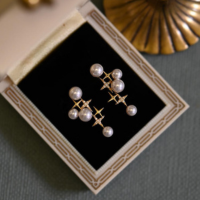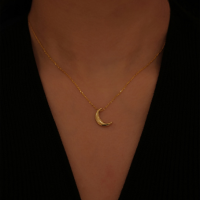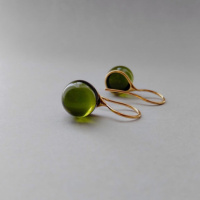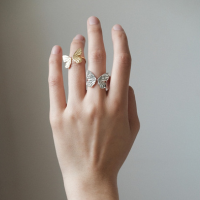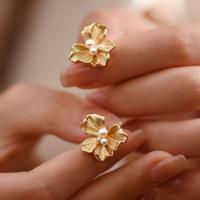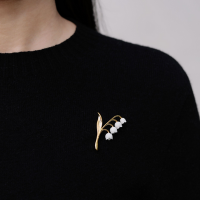
Understanding Metal Choices for Personalized Jewelry: Gold, Silver, and Beyond
Check out our personalized jewelry collections! (kids drawing jewelry, coin jewelry, wire jewelry, fingerprint jewelry, handwriting jewelry, and more)
Selecting the right metal for personalized jewelry can elevate any piece from ordinary to extraordinary. Whether we're drawn to the classic allure of gold, the timeless elegance of silver, or the intrigue of alternative metals, each choice brings its own character and charm. Knowing the properties and benefits of each metal helps us make informed decisions tailored to our style and needs.
Gold has always symbolized luxury and opulence, making it a favorite in the world of jewelry. On the other hand, silver offers a versatile and enduring appeal that complements a wide range of styles. More modern options, like titanium and platinum, introduce unique attributes for those looking to stand out.
We explore how these metals interact with gemstones and how personal preferences, such as allergies or sensitivities, can affect our choices. With a wealth of possibilities for customization, the right metal becomes a canvas for our personal expression.
Key Takeaways
- Understanding metal properties enhances personalized jewelry choices.
- Gold, silver, and alternative metals offer distinct advantages.
- Metal selection can be tailored to individual style and needs.
The Allure of Gold in Jewelry
Gold has long been cherished in the art of jewelry making for its radiance and timeless appeal. We explore the different forms of gold, delving into karats and purity, and provide essential advice on keeping your gold pieces looking spectacular.
Types of Gold Used in Jewelry
In jewelry, gold comes in several types, each with its unique charm. Yellow gold is classic, blending the metal with alloys such as copper and silver to achieve a warm hue. White gold, on the other hand, incorporates palladium or nickel, giving it a silver-like appearance.
Rose gold, a favorite for its romantic tint, is achieved by mixing gold with copper. Each type offers a distinct aesthetic, allowing for varied expressions in personalized pieces. The choice between them often depends on the desired look and how well the color complements an individual's style.
Understanding Karats and Gold Purity
Gold purity is indicated by its karat rating, affecting durability and appeal. A higher karat signifies more gold content, with 24K being pure gold.
Jewelry often uses 18K, 14K, or 10K, where the lower karat results in increased strength due to more alloy content. This balance of purity and practicality ensures that pieces withstand daily wear without losing their allure. When choosing, it’s vital to consider the intended use and desired blend between purity and durability.
Caring for Your Gold Jewelry
Maintaining gold jewelry requires mindful practices. We recommend storing pieces separately to prevent scratches. Cleaning should be done gently using warm water and mild soap, avoiding harsh chemicals that can damage the metal.
Regular polishing helps retain brilliance, particularly for white gold, which may need occasional re-plating to preserve its finish. Knowing these care techniques allows pieces to remain elegant and vibrant, preserving their beauty for years. This care helps us enjoy personalized jewelry that reflects both personal style and cherished memories.
Silver's Timeless Elegance
Silver holds an unmatched charm with its lustrous appeal and affordability. Delving into the differences between sterling and fine silver can help us make informed jewelry choices, while understanding maintenance tips is key to preserving its shine.
Sterling Silver Versus Fine Silver
Sterling silver, an alloy of 92.5% silver and 7.5% other metals, commonly copper, is prized for its durability. This combination offers resilience against wear while retaining silver’s sheen. Fine silver, at 99.9% purity, provides a softer but purer alternative, which might not be as practical for everyday wear due to its tendency to scratch or bend.
Sterling’s robustness makes it a favored choice for necklaces, rings, and bracelets that withstand daily use. Fine silver, while visually striking, suits pieces like pendants or earrings less exposed to potential damage. Its subtle color difference also offers a distinct appeal, making it suitable for specialized designs. By choosing between sterling and fine silver, we can align our jewelry’s function and aesthetics with our lifestyle needs.
Maintaining Your Silver Jewelry's Shine
Silver jewelry requires care to keep its lustrous appearance. Tarnish, caused by exposure to air and moisture, is the main challenge. Regular cleaning with a soft cloth can remove fingerprints and minor tarnish. For deeper cleaning, a mild soap and water solution is effective. It's vital to dry pieces thoroughly afterwards to prevent spotting.
Storing silver jewelry properly is equally important. Keep pieces in an anti-tarnish pouch or cloth when not in use to minimize exposure to air. Avoid placing them in direct sunlight or humid environments. We should regularly inspect for any signs of wear or tarnish, allowing us to address issues promptly and ensure our silver jewelry remains radiant.
Exploring Alternative Metals
As we broaden our horizons beyond traditional gold and silver, platinum, titanium, and tungsten each offer distinct advantages in the world of personalized jewelry. Considerations range from durability to modernity and prestige.
Platinum's Prestige
Platinum stands out with its unparalleled luxury and rarity. Known for its naturally silvery-white sheen, it requires minimal maintenance to keep its shine. This metal is ideal for those who value hypoallergenic properties, making it perfect for individuals with sensitive skin.
In terms of weight, platinum is heavier than other metals, adding a substantial feel to jewelry pieces. Its durability means it doesn’t wear away quickly, thereby preserving the intricate detailing of designs. While platinum can be more costly, its enduring value makes it an investment worth considering.
The Durability of Titanium
Titanium is synonymous with strength and lightweight comfort. It is corrosion-resistant, making it a great choice for those leading active lifestyles or frequently exposed to water. With its modern, sleek look, titanium appeals to the contemporary fashionista.
Unlike other metals, titanium is also scratch-resistant, maintaining its appearance over time. Being hypoallergenic, it serves as a safe option for sensitive skin. Custom engraving on titanium can be a bit more challenging, but its unique benefits often outweigh this difficulty for dedicated wearers.
The Modern Appeal of Tungsten
Tungsten has revolutionized jewelry with its unique qualities. Its remarkable hardness makes it scratch-proof, ensuring jewelry retains its pristine condition even with daily wear. The natural gunmetal-gray color of tungsten offers a modern, chic alternative to traditional metals.
Although tungsten rings can't be resized, the array of available styles and colors offers enough diversity to match any taste or preference. Tungsten’s affordability is another factor making it a popular choice, especially for those seeking a stylish and practical solution without compromising on longevity.
Jewelry Alloys and Their Significance
Choosing the right alloy can significantly enhance the style, wearability, and personal significance of our jewelry pieces. We'll examine the unique attributes that rose gold and white gold bring to the table.
Rose Gold and Its Romantic Hue
Rose gold offers a warm, pinkish tone that exudes romance and elegance. This alloy is crafted by blending yellow gold with copper and sometimes a touch of silver. The copper content is responsible for the distinctive blush color that many find uniquely charming.
Apart from its beauty, rose gold is highly durable and resistant to tarnish, thanks to its copper content. This makes it an ideal choice for personalized pieces we want to wear regularly without worrying about frequent upkeep.
Stylistically, it complements all skin tones and pairs beautifully with both vintage and modern designs. Rose gold's versatility allows it to be used in a plethora of settings, from minimalist bands to ornate, gemstone-studded creations.
White Gold and Its Contemporary Look
White gold boasts a sleek, modern appeal with its silvery-white sheen, achieved by alloying yellow gold with metals like nickel, palladium, or silver. This alloy is typically rhodium-plated to enhance its shine and provide an extra layer of protection.
One major highlight of white gold is its ability to mimic platinum’s look at a more approachable price point. It's perfect for those who appreciate a contemporary aesthetic while maintaining a connection to traditional gold.
It's an excellent backdrop for diamonds and colored gemstones, offering a sophisticated contrast. Our white gold pieces appear fresh and stylish, appealing to those who favor a clean, polished appearance. Whether it's for engagement rings or statement necklaces, white gold fits effortlessly with various styles and preferences.
Personalization Options in Metalwork
Personalized jewelry allows us to express our individuality with unique designs. Key elements include engraving techniques and custom metal blending, which offer a variety of stylistic choices.
Engraving Techniques and Styles
Engraving adds a special touch to jewelry by incorporating meaningful symbols, names, or dates. We can choose from laser engraving, which provides precision, or hand engraving for a more traditional look. Laser engraving is optimal for intricate designs due to its accuracy.
Hand engraving, on the other hand, adds a unique artisan feel to each piece. Different styles such as script, block letters, or decorative monograms offer diverse aesthetic options. Italic fonts provide elegance, while bold cases can project strength. With various styles available, we can personalize each piece to match personal tastes and sentiments.
Custom Metal Blending
Custom metal blending creates unique alloys with varied colors and properties. By combining metals like gold, copper, and silver, we achieve one-of-a-kind hues ranging from rose gold to green alloys.
We can select specific metal properties, such as hypoallergenic qualities or increased durability, based on individual preferences. For example, adding palladium can enhance strength while providing a sleek, white color.
Metal blending also allows us to achieve specific weight and flexibility, ensuring that the jewelry is comfortable and suitable for daily wear. With custom blends, every piece becomes a personal statement both in color and functionality.
Matching Metals With Gemstones
Pairing metals with gemstones is both an art and a science. It requires understanding color harmony, durability, and style to create stunning pieces of personalized jewelry.
Choosing the Right Metal for Your Stone
Different stones shine uniquely in various metal settings. Gold offers a classic look, making it ideal for rubies, sapphires, or emeralds. The richness of yellow gold complements these colors, enhancing their vibrancy.
For stones like diamonds or aquamarines, white gold or platinum may be better. Their neutral tones amplify the stone's brilliance and clarity. Silver is great for many semi-precious stones, adding brightness without overshadowing their softer hues. The choice of metal directly impacts how a gemstone's color is perceived and appreciated.
Settings and Metal Types
The type of setting influences both the style and durability of a piece. Prong settings elevate stones, allowing maximum light exposure, which is perfect for diamonds in platinum due to its strength.
Bezel settings, involving metal encircling the stone, offer protection but can slightly diminish light exposure, suiting softer gems like opal in silver or gold. We also consider the interaction between the metal and gemstone; for example, some stones, such as turquoise, may react poorly to certain metals over time. These factors guide us in creating jewelry that is both beautiful and functional, ensuring a lasting wear.
Understanding Metal Allergies and Sensitivities
When choosing jewelry, it's essential to consider potential metal allergies. Many individuals experience sensitivities leading to discomfort or even rashes when certain metals come into contact with their skin.
Common Metal Allergens:
- Nickel: Frequently found in both affordable and luxury jewelry. This metal is a common allergen and can trigger reactions for many wearing it.
- Chromium and Cobalt: Also known causes of sensitivity. These metals can irritate the skin if not properly alloyed.
We can opt for pieces crafted from hypoallergenic materials to prevent reactions. Hypoallergenic Choices include:
- Platinum: Virtually inert, hence an excellent option for those with severe allergies.
- Titanium: Lightweight and naturally hypoallergenic.
- Stainless Steel: Often alloyed to reduce reactions, though some variants may contain nickel.
Gold and Silver choices are also worth considering. Pure gold (24k) is typically safe, but alloys like 14k and 18k may contain smaller amounts of nickel. Sterling silver, generally marked 925, usually contains a small amount of copper that's less likely to cause irritation.
Minimizing Reactions:
- Opt for jewelry marked as "nickel-free".
- Regularly clean pieces to remove irritants like sweat and dirt.
This way, we can enjoy beautiful jewelry with peace of mind, knowing it fits our style while being kind to our skin.
Frequently Asked Questions
When exploring options for personalized jewelry, it's important to consider the unique benefits various metals offer. Let's dive into some of your questions about different materials and their appeal.
What are the benefits of using titanium in men's jewelry?
Titanium offers a lightweight option while being incredibly strong, making it an ideal choice for everyday wear. Its resistance to corrosion and hypoallergenic properties make it a comfortable and practical choice for those with sensitive skin.
How does rhodium compare to diamond in jewelry settings?
While rhodium isn’t used as a gemstone, its application as a plating enhances the shine and durability of jewelry metals. It's often used in settings to provide a bright, reflective finish that complements diamonds, adding a layer of protection against scratches.
What are some popular alternatives to traditional rose gold jewelry?
For those looking for something different, pink or red-tinted alloys like blush gold or peach gold are appealing options. These alternatives maintain a similar warmth but offer unique hues that can set your personalized pieces apart.
Which unique metals are favored for crafting men's wedding bands?
Palladium and tungsten are popular contenders, known for their durability and distinctive appearance. Palladium, part of the platinum group, brings a stylish white sheen, while tungsten provides an ultra-tough, scratch-resistant surface.
Are there any fashionable options for non-metal jewelry?
Materials like leather, wood, or ceramic bring variety to the table for those seeking non-metal jewelry alternatives. These can offer a more casual or avant-garde style, perfect for personalized, fashionable statements.
What should I consider when choosing metals for my jewelry pieces?
Consider the wearability, maintenance, and any potential allergies when selecting metals. Weigh the aesthetic appeal against practical needs to ensure your jewelry not only looks great but also suits your lifestyle seamlessly.

